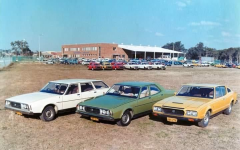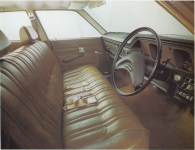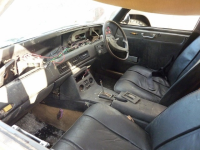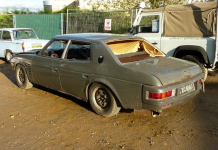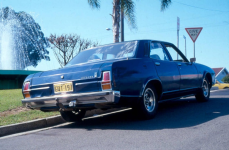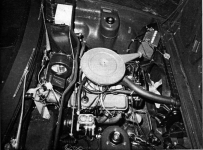This article is from the James Taylor FB page which allows articles to be reproduced if credited:
I’ve lost track of the number of times people have repeated the story that the Australian Leyland P76 was derived from the aborted Rover P8. No, it wasn’t! They were completely different cars. And here, for anybody who still isn’t sure, is a brief story of both of them so that you can see for yourself.
Thanks for reading the post that follows. It’s number 82 in the series that I started in July 2022. As always, I’ll ask you to click the “Like” button if you enjoy it. If you want to share it or copy it, please feel free to do so – but don’t forget to acknowledge where you found it. Please note, though, that “shares” do not automatically copy over the Comments and therefore the pictures that are included in them.
P8 INTO P76 DID NOT GO
The Rover P8 saloon started life as a set of ideas in 1964. Rover had just stopped production of the P4 range; the P5 3-litre introduced in 1958 held the top spot in the hierarchy; and the P6 2000 had just been introduced in 1963 as the less expensive Rover. It was not really a replacement for the P4, but deliberately took the company into a new market sector where there was more room for expansion.
It had all been rather expensive. Although booming Land Rover sales had allowed Rover to afford the technically advanced P6, and although the P6 itself proved a huge success, top management did not believe the company could afford to replace both P5 and P6 in the longer term. By 1964, the thinking was that there should be just one new model and that this, through different engine sizes and different equipment options, should eventually replace both cars. This new option was P8.
And then along came Leyland. This is not the place to go into how all that came about, but by early 1967 Rover had sought shelter in the arms of the Leyland Group. Leyland’s Chairman Sir Donald Stokes learned of the new technology that was under consideration for P8, and realised that it would make an ideal flagship model for the Leyland stable. It would provide very strong competition for the big saloons from Jaguar, who by this time had got together with BMC in British Motor Holdings. So he encouraged Rover to think big and to focus on the top models of the P8 rather than those that might eventually replace the P6.
That plan fell apart when BMH and Leyland were persuaded by the British Government to amalgamate in 1968 as British Leyland. The P8 was now being developed in direct competition with the big Jaguars, which was plainly nonsensical. Something had to give – but nothing did. Rover were allowed to carry on with the P8 with the aim of having it in production by 1972, spending several million on development and tooling that all had to be written off when British Leyland eventually realised it was a car they didn’t need.
So much for the background to P8. From the beginning, it was designed within Rover to meet anticipated European market expectations, and with one eye on the US market as well. Its visual aspect was created by David Bache, Rover’s acclaimed stylist, and although it might not have been to everybody’s taste, it was undeniably an imposing-looking car. Thanks to the Leyland insistence back in 1967 on competing with Jaguar, it was slated to have not only the 3.5-litre Rover V8 engine but also a new 4.4-litre version that had been planned as an eventual enlargement back when Rover took the engine over from Buick. Early P8 prototypes had the 4.4-litre engine, but for reasons that even Rover’s chief engine man Jack Swaine didn’t understand, the V8 transfer line tooling had not been designed to cope with the anticipated larger-capacity engine. The 4.4 was therefore written out of the script quite late in the development programme.
Over now to Australia, where the grouping together of several formerly separate British marques under the umbrella of Leyland Australia was rightly perceived as a golden opportunity. BMC cars for Australia had largely been adapted versions of their British counterparts, typically with bigger engines and heavy-duty suspension, but they had never been quite what Australians wanted. By the mid-1960s, cars like the Ford Falcon were showing the way ahead, and there was nothing in the Leyland stable that could compete.
But now, there could be. In 1967, Leyland Australia gained approval from its UK parent for a new two-model programme. There would be one large family saloon – large enough to compete with the latest offerings from Ford, Chrysler and Holden – and after that there would be a medium-sized (by Australian standards) saloon. These were known as the A model and the B model, and were given development codes P82 and P76 respectively. The coincidence of the P prefix should not lead you to assume any connection with Rover whatsoever – although some commentators have fantasised otherwise.
Let’s focus for the moment on the larger car, the P76. It was always intended to be sized to compete with domestic competition and was never a European or British-sized model. Designed around a wheelbase of 111.25in (2826mm), it was to have long front and rear overhangs that would make for an overall length of 192in (4900mm). Just compare that to the dimensions planned for the Rover P8, which was a big car by European standards: it had a wheelbase of 105.625in (2683mm) and was to be 178.5in (4534mm) long. That is well over a foot shorter than the Australian car, which had to have a large boot so that outback farmers could carry a 44-gallon drum in it. (If you don’t understand why they would want to, ask an Australian.)
Leyland Australia wanted their new car to have distinctive looks, and they decided that a European flavour was needed. So they drew on existing Leyland contacts and asked for the Italian design house of Michelotti to put forward a proposal. Michelotti was more used to doing considerably smaller sports cars and saloons for the likes of Triumph, but he rose to the challenge magnificently. The design engineers at Leyland Australia made some modifications that they thought would be better suited to their customers (remember Michelotti had a European orientation), and committed the design to production. Back at Rover, it is highly unlikely that David Bache and his team had any idea of what was going on Down Under, let alone any input to it.
The Australian requirement was for two major specification levels in the P76. The less expensive models needed a big six-cylinder engine, and the Leyland engineers settled on an enlarged version of the E6 type that was then in production for Australian versions of the BMC Land Crab. They also re-orientated it north-south to suit the rear-wheel-drive layout they wanted. Above that, they knew they needed a V8 because that was what the competition had. Where would they find a V8 that was big enough? Putting the question to their colleagues in Britain, they learned that Rover had designed a 4.4-litre V8 that they were now not going to use.
To cut a long story short, they grabbed it and made some minor changes to suit their own requirements. The 4.4-litre V8 entered production in Australia for the Leyland P76 and, with 192bhp, did exactly what was asked of it. Job done; all work kept in-house; and costs minimised.
So how have the stories of two different cars, designed at different ends of the same organisation for two very different markets, become so confused? Simple: it starts with the coincidence of that 4.4-litre V8. It goes on with the coincidence of Rover and Leyland Australia prefixing their model codes with a P. The timing of the P76’s appearance (1973) has led people to think that it was a follow-on from the Rover P8 (which was cancelled in 1971). And finally, to some eyes there are similarities of shape between the two cars. I find this hard to credit (and I’m sure both David Bache and Giovanni Michelotti would share that view). If there are similarities, such as the upward sweep of the waistline on the rear doors, they are simply those that come about between cars designed in the same era and subject to the same design influences.
OK, rant over. I feel a lot better now.
(The first two pictures show the P76 as a production car and the Rover P8 as a full-size mock-up in the studio. There are six more pictures in the Comments below.)
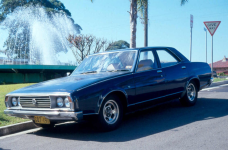

I’ve lost track of the number of times people have repeated the story that the Australian Leyland P76 was derived from the aborted Rover P8. No, it wasn’t! They were completely different cars. And here, for anybody who still isn’t sure, is a brief story of both of them so that you can see for yourself.
Thanks for reading the post that follows. It’s number 82 in the series that I started in July 2022. As always, I’ll ask you to click the “Like” button if you enjoy it. If you want to share it or copy it, please feel free to do so – but don’t forget to acknowledge where you found it. Please note, though, that “shares” do not automatically copy over the Comments and therefore the pictures that are included in them.
P8 INTO P76 DID NOT GO
The Rover P8 saloon started life as a set of ideas in 1964. Rover had just stopped production of the P4 range; the P5 3-litre introduced in 1958 held the top spot in the hierarchy; and the P6 2000 had just been introduced in 1963 as the less expensive Rover. It was not really a replacement for the P4, but deliberately took the company into a new market sector where there was more room for expansion.
It had all been rather expensive. Although booming Land Rover sales had allowed Rover to afford the technically advanced P6, and although the P6 itself proved a huge success, top management did not believe the company could afford to replace both P5 and P6 in the longer term. By 1964, the thinking was that there should be just one new model and that this, through different engine sizes and different equipment options, should eventually replace both cars. This new option was P8.
And then along came Leyland. This is not the place to go into how all that came about, but by early 1967 Rover had sought shelter in the arms of the Leyland Group. Leyland’s Chairman Sir Donald Stokes learned of the new technology that was under consideration for P8, and realised that it would make an ideal flagship model for the Leyland stable. It would provide very strong competition for the big saloons from Jaguar, who by this time had got together with BMC in British Motor Holdings. So he encouraged Rover to think big and to focus on the top models of the P8 rather than those that might eventually replace the P6.
That plan fell apart when BMH and Leyland were persuaded by the British Government to amalgamate in 1968 as British Leyland. The P8 was now being developed in direct competition with the big Jaguars, which was plainly nonsensical. Something had to give – but nothing did. Rover were allowed to carry on with the P8 with the aim of having it in production by 1972, spending several million on development and tooling that all had to be written off when British Leyland eventually realised it was a car they didn’t need.
So much for the background to P8. From the beginning, it was designed within Rover to meet anticipated European market expectations, and with one eye on the US market as well. Its visual aspect was created by David Bache, Rover’s acclaimed stylist, and although it might not have been to everybody’s taste, it was undeniably an imposing-looking car. Thanks to the Leyland insistence back in 1967 on competing with Jaguar, it was slated to have not only the 3.5-litre Rover V8 engine but also a new 4.4-litre version that had been planned as an eventual enlargement back when Rover took the engine over from Buick. Early P8 prototypes had the 4.4-litre engine, but for reasons that even Rover’s chief engine man Jack Swaine didn’t understand, the V8 transfer line tooling had not been designed to cope with the anticipated larger-capacity engine. The 4.4 was therefore written out of the script quite late in the development programme.
Over now to Australia, where the grouping together of several formerly separate British marques under the umbrella of Leyland Australia was rightly perceived as a golden opportunity. BMC cars for Australia had largely been adapted versions of their British counterparts, typically with bigger engines and heavy-duty suspension, but they had never been quite what Australians wanted. By the mid-1960s, cars like the Ford Falcon were showing the way ahead, and there was nothing in the Leyland stable that could compete.
But now, there could be. In 1967, Leyland Australia gained approval from its UK parent for a new two-model programme. There would be one large family saloon – large enough to compete with the latest offerings from Ford, Chrysler and Holden – and after that there would be a medium-sized (by Australian standards) saloon. These were known as the A model and the B model, and were given development codes P82 and P76 respectively. The coincidence of the P prefix should not lead you to assume any connection with Rover whatsoever – although some commentators have fantasised otherwise.
Let’s focus for the moment on the larger car, the P76. It was always intended to be sized to compete with domestic competition and was never a European or British-sized model. Designed around a wheelbase of 111.25in (2826mm), it was to have long front and rear overhangs that would make for an overall length of 192in (4900mm). Just compare that to the dimensions planned for the Rover P8, which was a big car by European standards: it had a wheelbase of 105.625in (2683mm) and was to be 178.5in (4534mm) long. That is well over a foot shorter than the Australian car, which had to have a large boot so that outback farmers could carry a 44-gallon drum in it. (If you don’t understand why they would want to, ask an Australian.)
Leyland Australia wanted their new car to have distinctive looks, and they decided that a European flavour was needed. So they drew on existing Leyland contacts and asked for the Italian design house of Michelotti to put forward a proposal. Michelotti was more used to doing considerably smaller sports cars and saloons for the likes of Triumph, but he rose to the challenge magnificently. The design engineers at Leyland Australia made some modifications that they thought would be better suited to their customers (remember Michelotti had a European orientation), and committed the design to production. Back at Rover, it is highly unlikely that David Bache and his team had any idea of what was going on Down Under, let alone any input to it.
The Australian requirement was for two major specification levels in the P76. The less expensive models needed a big six-cylinder engine, and the Leyland engineers settled on an enlarged version of the E6 type that was then in production for Australian versions of the BMC Land Crab. They also re-orientated it north-south to suit the rear-wheel-drive layout they wanted. Above that, they knew they needed a V8 because that was what the competition had. Where would they find a V8 that was big enough? Putting the question to their colleagues in Britain, they learned that Rover had designed a 4.4-litre V8 that they were now not going to use.
To cut a long story short, they grabbed it and made some minor changes to suit their own requirements. The 4.4-litre V8 entered production in Australia for the Leyland P76 and, with 192bhp, did exactly what was asked of it. Job done; all work kept in-house; and costs minimised.
So how have the stories of two different cars, designed at different ends of the same organisation for two very different markets, become so confused? Simple: it starts with the coincidence of that 4.4-litre V8. It goes on with the coincidence of Rover and Leyland Australia prefixing their model codes with a P. The timing of the P76’s appearance (1973) has led people to think that it was a follow-on from the Rover P8 (which was cancelled in 1971). And finally, to some eyes there are similarities of shape between the two cars. I find this hard to credit (and I’m sure both David Bache and Giovanni Michelotti would share that view). If there are similarities, such as the upward sweep of the waistline on the rear doors, they are simply those that come about between cars designed in the same era and subject to the same design influences.
OK, rant over. I feel a lot better now.
(The first two pictures show the P76 as a production car and the Rover P8 as a full-size mock-up in the studio. There are six more pictures in the Comments below.)


Last edited:


